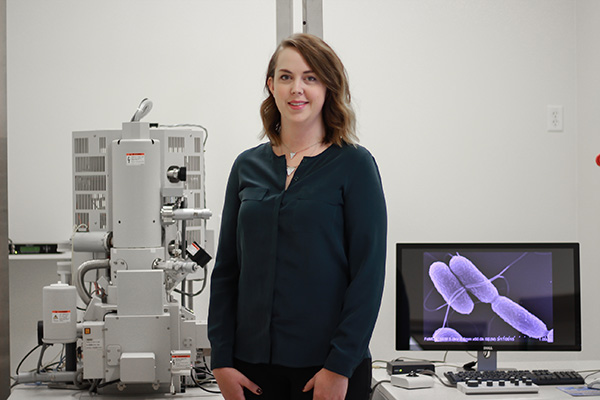
The FARM Research Equipment Database catalogs equipment worth $25,000 or more. Colleen Sunderland was part of the team that made the database possible. Photo credit: Melissa Fabrizio
Scientific research equipment costs money to maintain and operate. A new database developed by the Faculty of Medicine & Dentistry's Office of Research makes it easier for faculty members to find resources available for them to carry out their research. TheFARM Research Equipment Database catalogs equipment worth $25,000 or more.
The database was outlined in the faculty's 2016-21 Strategic Plan and is now up and running. It currently has 493 items and is a unique resource on campus.
"We wanted to capture equipment that is really specialized, we don't want unnecessary duplication of equipment and we want to ensure that the equipment we have is utilized," said Colleen Sunderland, a research analyst who was instrumental in setting up the database.
The FoMD has received more than $150 million in equipment from the Canadian Foundation for Innovation and the Natural Sciences and Engineering Research Council since 2006, which has resulted in a substantial amount of infrastructure. Aside from the main core facilities, there are an additional 25 equipment facilities and centres affiliated with FoMD.
"People might not know what their neighbours have. Using the database allows people to start a new line of discovery using different equipment without needing to apply for new funding," said Sunderland. "If someone wants to try a new experiment, they can do a test pilot."
David Evans, vice-dean, research believes the database is necessary due to the sheer size of the faculty. Researchers are often not aware of the availability of existing equipment.
Evans recalls that when he first started his role as vice-dean, research, the office kept receiving requests for confocal microscopes. When they did some digging, they found there were already about 20 in the faculty.
Evan says the faculty is fortunate to have expert staff and technicians that operate equipment and provide training. If researchers are sharing equipment and using it more efficiently, the equipment will operate better. He says such specialized equipment cannot simply be turned on and off and sit idle for long periods of time.
"By having people share equipment, people talk also to each other and share the expertise that underpins the operation of the equipment," said Evans. "People get better quality of data by sharing their knowledge of how this complicated equipment is best operated."
Evans is grateful for the researchers whose work contributed to the extensive catalogue of equipment.
"Individual investigators spend a great amount of time applying for grants, their work helps the whole faculty," said Evans. "By ensuring that the equipment is shared and maintained, they operate better and their students get better training."